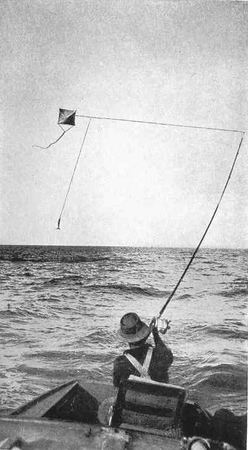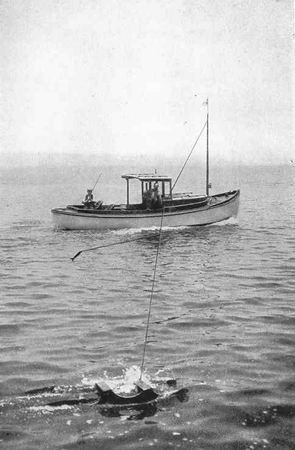|
1999-2003 (Return to Web Text-ures) |
Click Here to return to |
|
1999-2003 (Return to Web Text-ures) |
Click Here to return to |
VII
FISHING WITH KITE AND SLED
“ALL THAT ARE LOVERS OF
VIRTUE,. . . BE QUIET AND GO A-ANGLING.”
Walton.
NO one has ever been able to decide what causes fish to change their habits, yet every fisherman has theories on the subject.
When I first visited Catalina Island in 1900 the tuna were very plentiful and could be taken by simply trolling a hundred feet of line behind a launch, with a flying-fish for bait.
I captured five in six hours, averaging one hundred pounds in weight, and landed thirteen fish in fifteen days’ fishing within five miles of Avalon.
On my second visit in 1910 it was impossible to persuade a tuna to take unless the bait was skittered in front of his nose and the fish persuaded that the flying fish was alive. Why this change?
Some of the fishermen maintained that the tuna had become educated and therefore more difficult to deceive. They are a migratory fish and it is hardly probable that the same schools return as a rule to the waters of the Channel Islands, especially as the fish have the habit of disappearing entirely for years at a time.
The fact remains that the schools of fish would vanish if approached by a boat and would not follow the wake of a launch under any circumstances.
Skittering a one-pound bait with a rod is hard work, so kite fishing was invented at Avalon for this purpose and proved to be a great success, and it has become the belief that no one can take a tuna these days by any other means.
The kite used is a simple 28 inch or larger boy’s kite made preferably of silk with the usual rag tail to which are added a few wine bottle corks to make the kite float should it fall into the sea.

FISHING WITH A KITE
The kite is allowed about seven hundred feet of old fishing line from off a reel, and then the fisherman’s line is tied to the kite line about twenty feet from the bait with a piece of cotton twine. The kite is then given more line in order to place the bait at the proper distance from the launch.
The launch then travels across the wind or tacks down wind, the boatman adjusting the speed and direction so as to make the flying-fish bait skitter along the surface and jump from wave to wave, which action the fisherman can aid with his rod.
The boatman manoeuvres the boat so that the bait passes ahead of the school of fish or through the school if so inclined. The bait being well to leeward the fish are not disturbed or frightened by the launch.
When a tuna takes the bait the cotton line breaks and the kite is reeled in or falls into the sea according to the direction in which the hooked fish travels.
Many fish have been captured by this means which could not otherwise be persuaded to take.
Some of the boatmen at Avalon have become artists in kite fishing for it is not as simple as it reads, as the kite must fly steadily and the bait be kept moving in a natural manner, for although it is easy to fool some fish sometimes it is not easy to fool all the fish all the time.
For a kite to fly, there must be wind and wind of the proper weight. It must not blow too light nor too heavy, for in the latter case it is difficult to keep the bait on the surface of the water.
In order to find a substitute for the kite the wise men of the Tuna Club put their heads together and invented or adapted sled fishing. I say adapted, for poachers in Great Britain have for years used a sled in some fast running streams in order to place a shrimp or bunch of worms in mid-stream so as to steal other people’s salmon and trout.

FISHING WITH A SLED
The sled used at Catalina is a roughly made boy’s sled about three feet long with solid runners well tipped up in front. The top of the sled instead of being solid has two cross boards about six inches wide and six inches apart screwed on to the runners at a slight slant so that the sled will not bury but will ride the waves. A strong eyebolt is screwed through each top board and down into the nigh runner and these are joined by a light but strong rope.
To this rope one hundred or more feet of light cotton rope is attached at about one third of the length of the sled from the fore end of the runner. For instance, in a three foot sled it would be made fast one foot from the fore end. The baited line is tied as in kite fishing at whatever distance you may choose from the sled. The leading line is then played out eighty or one hundred feet and made fast to the mast, the higher up the better to keep the belly of the line from dragging in the water.
The launch is then started at a good pace and as soon as the leading line becomes taut the sled races along abreast of the boat in gallant style and the bait skitters and bounds from wave to wave.
When a fish strikes, your line pulls free but the impetus of the sled is such that the fish seldom escapes being hooked.
The sled does not frighten the fish in the least. Marlin have been known to follow and strike it and yellowtail to chase in hot pursuit.
By this method the boatman can place the bait wherever it is wanted.
In yellowtail fishing the bait can be trolled along the edge of the kelp, which the yellowtail frequent, and this cannot be done by ordinary means as the kelp fouls the propellor of the launch.
These methods of fishing are full of movement and are most amusing as well as successful ways of taking both tuna and yellowtail.
Click
here to continue to the next chapter of
Some Fish and Some Fishing